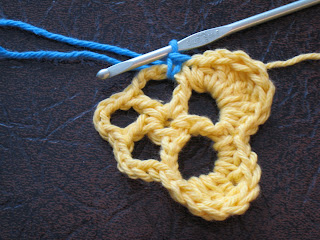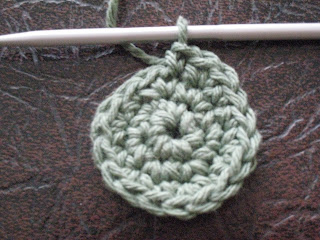 We made a rose. How about designing a pansy? A pansy generally has 5 petals so we'll start out with 5 spokes instead of 6.
We made a rose. How about designing a pansy? A pansy generally has 5 petals so we'll start out with 5 spokes instead of 6.For the rose there were 6 spokes with a ch 3 in between for a total of 24 sts around. We'll try 25 for the pansy (since 25 is close to 24 and is divisible by 5). I'm going to start with a smaller initial chain loop – just to be different. I'm also using triple crochet sts for a little extra height since we're only going to have one round of petals.
The flower begins essentially like the Irish crochet rose – with a center chain loop and spokes. The petals are worked differently. The first picture shows the 5 spokes plus 2 petals. The last sc of the second petal isn't finished. Why there's a picture of an unfinished sc will become apparent later.
 Here is the pattern:
Here is the pattern:Pansy
I used a size 5 or F (3.75 mm) crochet hook and leftovers from a couple of balls of Peaches & Creme cotton yarn – worsted weight -- in yellow and blue. Yellow is the color for the center and the first 2 petals.
This is my own pattern, just made up yesterday especially for this blog.
The flower is about 3 ½ " in diameter.
Instructions:
Ch 4. Join to form ring.
Rnd 1: Ch 7, * dc 1, ch 4 * 4x, join with slip stitch to 3rd st of ch 7. (5 spokes)
Rnd 2: In each of the first 2 loops work "sc 1, hdc 1, dc 1, tr 3, dc 1, hdc 1, sc 1". If desired, change colors. In each of the remaining 3 loops work "sc 1, ch 3, tr 2, dc 1, tr 2, ch 3, sc 1".
 That's all there is to the pattern -- except for fastening off and weaving in the ends.
That's all there is to the pattern -- except for fastening off and weaving in the ends.There are several ways to change colors. One way is to fasten off the old color and then start with the new. However, for the pansy, I changed colors by just starting to crochet with the new color.
For that method, for the last sc of the second petal, don't draw a loop of yellow through to complete the sc. Instead draw a loop of blue through. (The loop created when finishing a st is the top of the next st. This is shown in the second picture.) That is all there is to it. (One, of course, needs to weave in the ends. But, whatever technique you use, you'd need to do that.)
Note also: Just as the ch 3 (the first part of the ch 7 at the beginning of round 1) is a substitute for dc 1, "sc 1, ch 3" and "ch 3, sc 1" are substitutes for tr 1.









